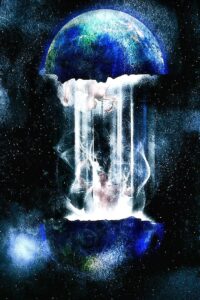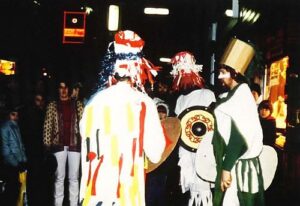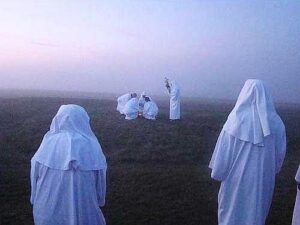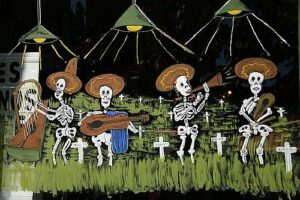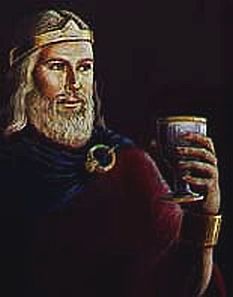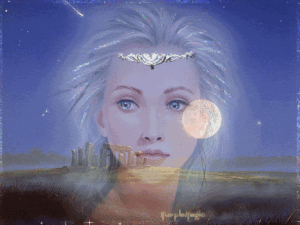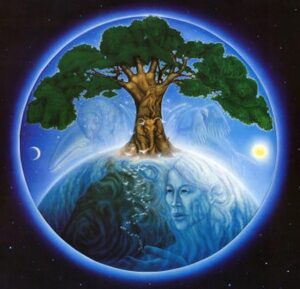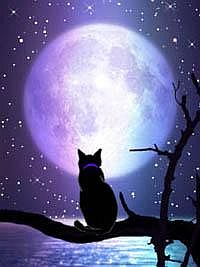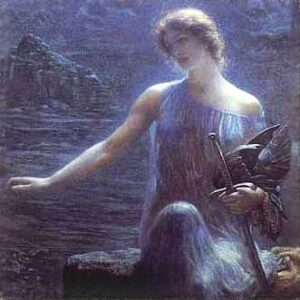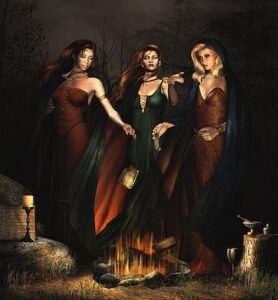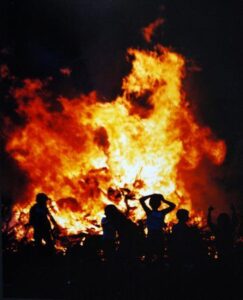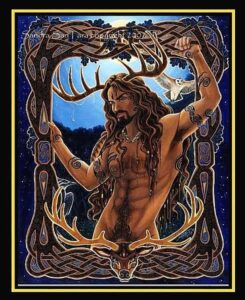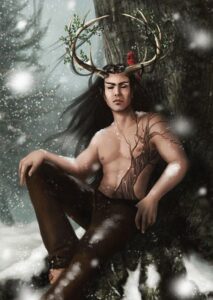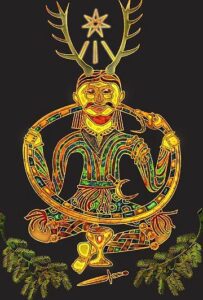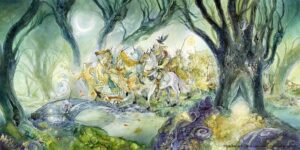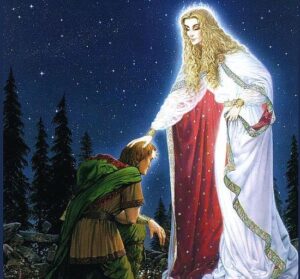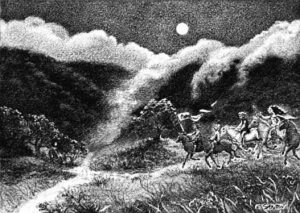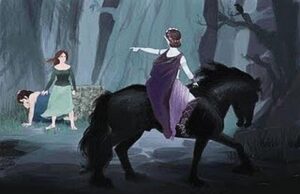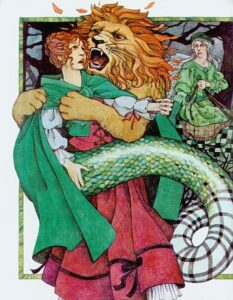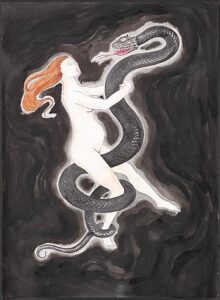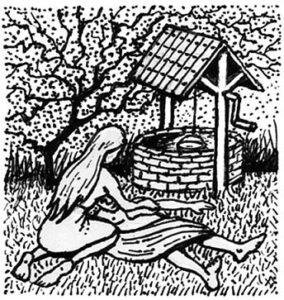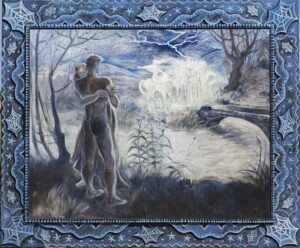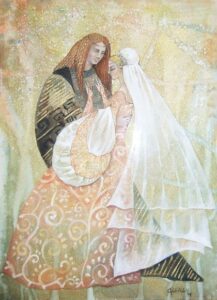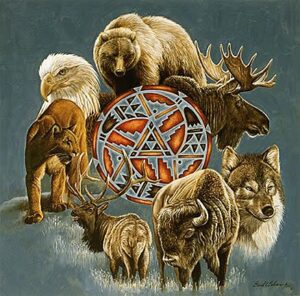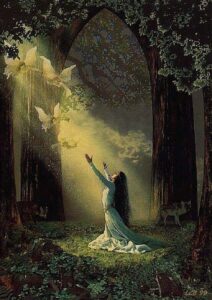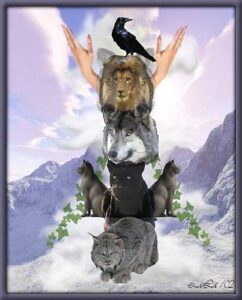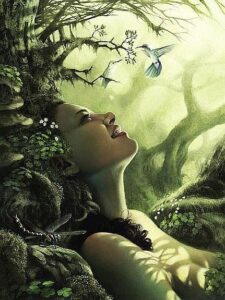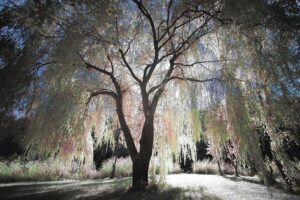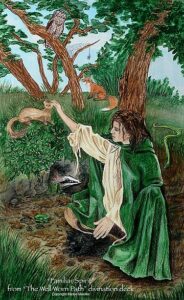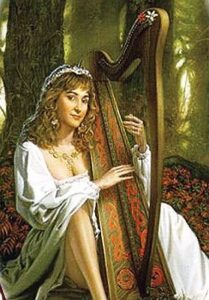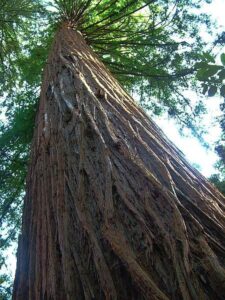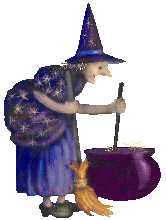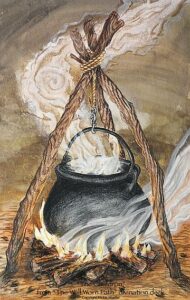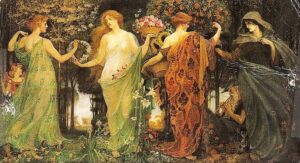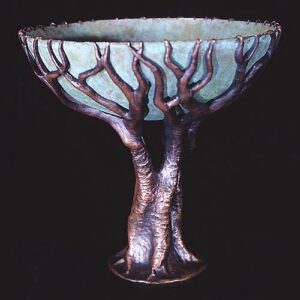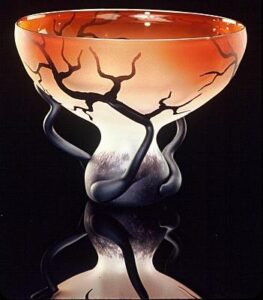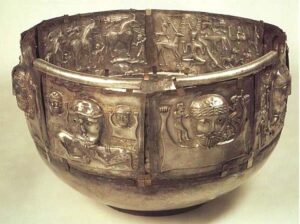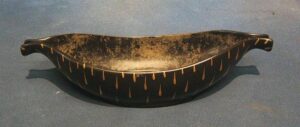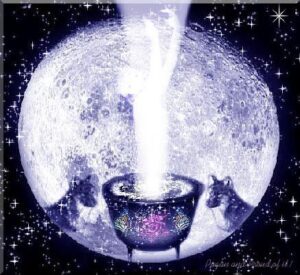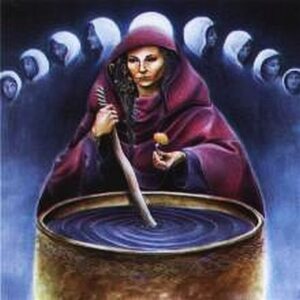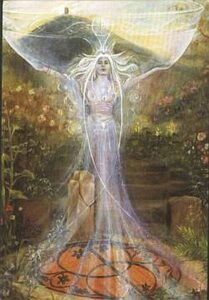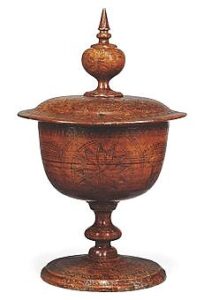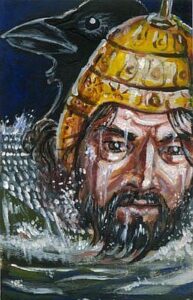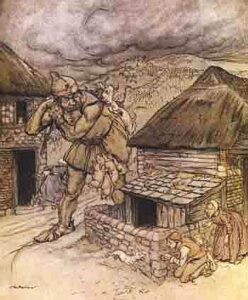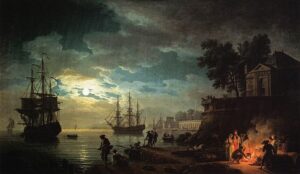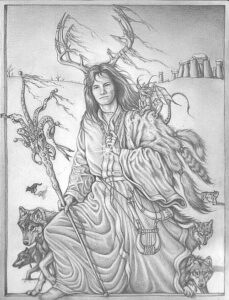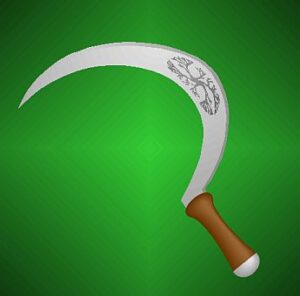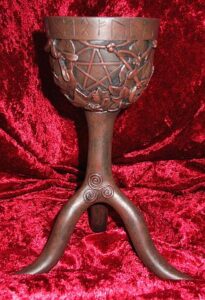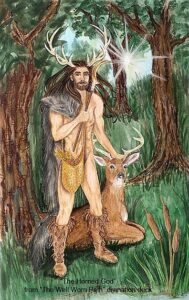|
An “Official” Publication of the Reformed Druids Samhain – Yule ce 2010 |
![]()
Message from the
|
|
There is a bite in the air, and the days grow shorter, signalling a time to retreat inside, stoke up the fire, and begin to turn inward – seeking guidance…seeking visions… My namesake, the Welsh Crone Goddess Ceridwen, invites you to come into her cave. You feel an inner prompting and – as you have been taught to do with your intuition – you follow it with curiosity and a sense of adventure… The moon has just risen, lighting up the entrance to her cave. Taking Eventually you come to a fountain built into a niche in the wall, and you You then begin to notice a faint glow coming from up ahead. The “calling” Ahead of you sits the Goddess Ceridwen, stirring her cauldron of inspiration With a voice like the wind murmuring through the trees, she asks, “The next step on my path – I feel like I’m at a crossroads, and I “Are you willing to go into the cauldron to find that which you seek?” Hesitating a moment as you stare at the boiling water and smell the strange You realize you can breath in this water, and you swim downward and downward. Visions begin to appear to you, and the voice of your higher self and those of your Guides begin to speak to you, answering your questions even before you can ask them. They show you scenes and tell you all that you need to know to proceed along your path… When you are ready, you swim upward and upward until your head breaks Ceridwen is looking at you with such wisdom and love and a knowingness
“Oh yes, Goddess, I have!”, you answer, and express your gratitude for her guidance. You reach into your pocket, remembering that you brought a gift for her, and you hand it to her. She accepts it gracefully and reaches behind the cauldron…then holding her hand out to you, she gives you a token to take back with you to remind you of your experience – and she tells you that you can come here any time you seek guidance, love and support on your life path…she will always be here for you, and loves you unconditionally! After thanking her again, you make your way out of the cave and into the cold, crisp air – the full moon high up in the sky, lighting your way home… Seasonal blessings, *In real life: “Karyn Arseneau” |
![]()
|
Samhain Lore
|
Song to Herneby Lucidian
|
Alba cona Lingantaibhby Seonaid |
|
You who have been in the charmed West have seen the gloom and Not otherwise can one love it aright: “Tir nam Beann Inman In the mythology of the Gael are three forgotten deities, children
If we could hear the wind blowing along Magh Mell — the Plain It may well be that the Celtic Dream is not doomed to become Enjoy a beautiful winters day… my best friend is Cailleach and
|
![]()
Three Winter PoemsGenerously contributed by OMS/RDG Druid
|
Harvesting MyselfSummer is abundant and green Cusp between opposite seasons Abundance and shedding Each year is different
Winter NightI lit a candle last night
Going WithinLate afternoon light slants across the lawn
|
![]()
Charge of the Horned God |
|
[Editor’s note: I have adapted this invocation to the Reformed Druid’s Horned God – Dalon ap Landu…from Hear ye the words of Cernunnos, the voice of the Horned One, I am the wild hunter of the forest deep, The thunder is my hoof fall; I am a stag, a tree and mountain. To such as thee, my hidden children For I am the Lord of all life.
Yet to my hidden children, who know and love my spirit, From death thou shalt be reborn, unto new life and love. My faces outnumber the stars.
~~ Source Unknown ~~ |
![]()
|
|
|
[Editor’s note: Since there are so many versions of this song, I put this one together from parts of various ones…]
At Carterhaugh in the borders, where many a strange thing has happened, and there is many a door to Elfland, and it is better NOT to go in, there was a fairy well, and this is the rhyme about it… Oh I forbid you maidens all Tam Lin was a lad who’d been taken away to Elfland, and had an uncanny fame. The girl who lingered by that well would come under his power, and must pay a fee: either a ring, or a silken cloak, or her maidenhead… And there was a lady called Janet, who was daughter to a great Lord. She wore gold on her hair, and her hair was golden, a gold ring, and a silk gown, and a mantle green as grass. Gold and fair, she was, with the colours of Spring. And heedless of warning, she went one morning to Carterhaugh, walking swiftly, her green skirts kilted out above her knees, her yellow hair in a braid ‘round her head. When she came to the well, she saw no man, but a horse was grazing there, and it was Tam Lin’s horse. A rosebush grew by the well, and Janet pulled a spray of two intertwining roses. Hardly had she done so, when Tam Lin appeared, gray-green his eyes, “Carterhaugh is on my father’s land,” said proud Janet, “and I’ll come here with or without your leave and pull a rose if I will!”
“Then,” said Tam Lin, taking her by the hand, “you must pay my fee.” He put his arm around her and led her away, and Janet was not unwilling. And after awhile, there was a sweet silence, and the scent of crushed rose petals on And at the end of that golden day, she went back to her father’s castle, still with her green mantle, still with her gold ring, but without her maidenhead… And a change slowly stole over fair Janet – one that could not be missed by her family. Out then spoke her father dear “If If The And Janet kilted her green kirtle above the knee, and was away to Carterhaugh as fast as she could go. She came once more to the well and pulled a double rose, and as before, Tam Lin appeared before her. “You must tell me,” cried Janet, “for my babe’s sake, if ever you set foot in holy chapel and learned the ways of Christendom?” And Tam Lin replied, “Roxburgh “There “And
“But every seven years the Queen must pay a tithe to hell for her powers, and I fear this time it will be myself – for the seven years have passed, and tonight is Hallowe’en…and yet at this time, when the two worlds meet, there IS a chance to save me, Janet. “Tell me, my love, how I may,” said Janet, looking at him with steadfast eyes.
Tam Lin replied, “You must go to Miles Cross, in the deep of the night and fill a cup with holy water. Then make a circle ‘round you with it. The Fairies will ride past in companies. Let the first company ride past and say nothing. Oh, first let pass the black lady For some ride on the black lady Because I was an earthly knight
“When you know me, you must take my horse by the bridle and snatch the reins from me. When you let them fall, I shall slip down from my horse, and the queen will cry out, ‘True Tam Lin, stolen away!” Then come fair or come foul, you must hold me tightly. First, they will turn me to a lizard, then to a lion, then to a snake. Hold me fast. I will then be turned into a bar of red-hot iron. But if you love me, you must not let go, however much it burns. Last of all, they’ll turn me into molten lead. Then you must carry me to the well, and cover me in there with your green cloak. Only then can I be your ain true love once more,” They’ll Tam Lin had vanished, and at sunset the next day, Janet stole away to the greenwood; and in the deep of the night, went to Miles Cross. She made the circle of holy water around her, and she waited… About the dead hour of the night
And it fell out, just as Tam Lin had told her. First, a company There rose an unearthly cry, “True Tam Lin, stolen away!”
But now, instead of holding her true love in her arms, Janet is grasping a By the lightning, she could see his body, looking as if it were made of some dull grey metal. She felt it begin to shrink into itself as it lost it’s definite She remembered the well to her right side, and began taking small, short steps towards it. A closer strike of lightning showed her where the well was just before she ran into it. Leaning over the edge, she dropped the still-melting lead that was Tam Lin into the water. The liquid steamed and boiled as the metal entered it. Quickly she pulled off her cloak and layed it atop the water. The steam began to emerge from around the edges, seeming more frantic than before. Now it should only be a short time…
They shaped him in her arms, at last, Out
“Farewell you to, Tam Lin,” the Elf Queen cried, “but know you this: if I had known yesterday what I know tonight, I would have changed your heart of flesh for one of stone, your two gray eyes to eyes of wood, and I would have paid a ransom seven times to the fiend so that I could have kept you.” Then she and her knights vanished, and fair Janet and Tam Lin went back to the castle, where they were married amidst great rejoicing.
|
![]()
Nature Spirit Magickby Larry Cornett
|
![]()
A Druid’s PledgeGenerously contributed by OMS/RDG Druid
|
|
Towering three hundred feet high Trillium bloom pink purple and white A single robed figure stands The trees lean nearer Time stops ceases to fly
|
![]()
The Cup of Life |
|
“Round Shakespeare’s “Macbeth”
The aged green warty witch stirring her steamy brew in a cast iron cauldron is a well known stereotype. Depicted in countless movies, plays, and media of all sorts, the old woman is a living memory of an ancient European past. Boiling and bubbling, Shakespeare tells us 3 witches, priestesses of the goddess Hecate, stirred and cackled, peered into their cauldron’s depth’s, and offered Macbeth their insights on the future. A remnant of the past but not resigned to it, the old wizened woman and her cauldron yet appear in countless Halloween decorations, costumes, and theater. But who exactly is that old granny, and what is cooking in that pot? Is it death… or life?
The magical cauldron and it’s mysterious contents have been a staple of pagan lore and practice long before the early Christian Church incorporated it’s elements into the medieval tale of the Holy Grail. Magic cauldrons appear in many Indo-European myths as the purveyors of transformation, and under the guise of cauldrons, pots, chalices, cups, horns, and dippers of various configurations. In these tales, the cauldron is usually stirred by a goddess, often the old hag or crone which represents the death aspect of the creatrix. Though her identity has been forgotten by many, the green aged witch of Halloween is based upon a powerful and ancient concept that death itself must answer to a higher authority, and contained within is the power to transform death into life, a mystery echoed by the green of the crones skin which reflects the color of nature and reminds us of both it’s wintry decay and it’s renewal in the spring, and by the spiraling and spinning nature of her brew.
As a youthful goddess depicting the fruitful early half of the year, and as an aged crone representing the winter, the goddess of our matriarchal ancestors still reverberates throughout the season, and as the year turns towards winter, she offers us the cauldron in remembrance that this season too shall pass and be renewed in the spring.
To our European ancestors, the cauldron served as the symbol of the great mother and her transformative womb. Many Indo-European myths focus on the concept of the dead being placed into the cauldron, then revitalized into the full flower of youth. Often these myths come to focus at the winter season, at a time when both the greenery of nature and the sun seem to fade away and is then divinely renewed.
Some tales abound with the magical properties of the cup itself, whereby a The first physician, one white robed Dhanwantari, filled a cup with Amrita which was then borne away by the goddess, yet even this brief contact granted him the ability to heal. A lovely myth, and yet here the “sea” has another meaning.
In ancient cultures round the world, the sea was a metaphor for the boundless depths of the starry night sky. The tale reveals the Hindu belief that once, the universe was a void, but then began to churn. And one on Earth need only look into the night sky to see the heavenly cup, the Big Dipper, endlessly spinning around the celestial pole with it’s life giving contents. Another Hindu tale says the moon god Chandra possessed a cup containing such a nectar of life, called Soma. A milky substance brewed from certain plants on sacred mountains, it is known that the ancients performed rituals that included the quaffing of the divine elixir. In honor of this cup, Hindu Brahmins carried coconut shell cups as religious implements. As an example of how highly the sacred cup ranked in popular belief, and revealing the symbology of the cosmic womb, another tale proposes that a Hindu man once saw a beautiful woman bathing in the sacred Ganges River. Drawing some of it’s water into a wooden bowl, the man spilled his sperm into it, and from the bowl was birthed a newborn son.
The Greek gods had a similar magic cup, this time filled with Ambrosia, the “nectar of the gods” which granted them immortality and beauty. A Greek tale tells us that Medea was a sorceress, daughter of Aetes. Her magical kettle was said to restore lost youth. “Medea cut an old ram into pieces, threw the bits into her cauldron, and a young lamb came forth.” Another variation of the same story says the sorceress Circe, the divine daughter of the sun, lived on an island and owned a magic cup that had the power to transform those who drank from it.
Yet one of the most famous Greek examples of the cauldron appears in the cult of Dionysus, the god of wine and renewal. The god Dionysus – born in a cave from a virgin on December 25th at the winter solstice – was later killed and resurrected. His rituals involved sacrifices and a sacred communion with a cup of blood that was shared among his followers. This blood was thought to renew one’s life, and the practice continued well into the second century bc, after which it was downgraded to drinking wine symbolically turned “into blood”. Nearly identical to the Greek cult of Dionysus, was the Roman cult of Bacchus. Also the god of wine and renewal, his name remains with us today in the term “bachelor”. Yet another Roman god’s cult remains with us more strongly then in just a name. Originally worshipped in Persia and later by the Roman military, the god Mithra appears in some Indo-European lands as the god of renewal and resurrection. As with many pre-Christian gods of the same genre, Mithra was born of a virgin in a cave or rock on December 25th at the winter solstice, he later died and resurrected. The infrastructure of the Mithra cult served as the foundation for the Catholic Church, which was to follow centuries later. His rites included a sacrifice of a bull whose blood was believed to wash away sins and grant the power of renewal. Scholars now believe that this act creates a “timestamp” of the distant past, and reveals the sun god’s connection to the constellation Taurus, for at one time, the spring equinox occurred in this sign. Conducted at the Temple of the mother goddess Cybele, the land on which it stood was later to become the Vatican in Rome. Led by a priest called the Pater (Father), followers shared a communion of small loaves of bread marked with a solar cross and a bowl of wine, believed transmuted into the sacred bloodshed for them.
The Gundestrup Cauldron, found in Denmark and which dates from the 1st century bc, has a scene which is nearly identical to the ancient Greek beliefs. Souls of the dead are depicted marching up one side of the tree of life, and down the other. Under the roots of this cosmic tree that represents the pole, is a goddess who one by one, dips the dead into the cauldron of rebirth. One may assume that like the Hindus, the Norse believed one might climb the sky and enter this celestial cup. Ancient Norse also routinely included cauldrons in ritual practice. A group It has also been noted that the Norse invaders in ancient England were known for cooking victory feasts in great cauldrons that rested on the bodies of the enemies. The Norse and the Scythians both drank from the skulls of their enemies, made into elaborate and decorated chalices in the belief that an enemies attributes of bravery and courage could be absorbed into one’s own being.
In honor of their god Bragi, the Norse would pass a special boat shaped Norse cauldrons are also often associated with the brewing of godly nectar, but rather then ambrosia, the drink of choice is mead. In one saga, the 12 deities that represent the zodiac are invited to a feast, but must first secure a kettle to concoct a brew fit for the gods. In a complex plan which involves stealing the immense cauldron of the giant Hymir, the god Thor manages to get the cauldron to Asgard where it remained the sole source of the god’s homebrew.
And finally, the Norse believed that the valiant dead, those who had died gloriously in battle had earned the right to have a seat in Valhalla, the eternal hall of heroes. Daily they would regale themselves with tales of their heroic deeds, drink beer and eat magical pork. The meat would come from a pig called Saehimnlr. Each day the same pig would be cooked in the cauldron of the goddess, and yet each day would appear renewed and intact, ready for another meal. In Ireland, tales are still told of the mysterious fairy race called the Tuatha De Danann, who arrived on ancient Irish shores and founded four magical cities, each with it’s own treasure, one of which was the magic cauldron of the Dagda. It was believed this cauldron could also magically produce food and its supply would never run dry. In Slavic lands, the goddess Baba Yaga was believed to fly through the air during the harvest season, sitting in a giant cauldron and steering with her broom.
The Welsh goddess Ceridwen had a magic cauldron named Amen, which Identical to earlier pagan beliefs, a Middle Age mysticism surrounded the idea of the Grail, attributing to it the power to cure the sick, and even empower objects that came in contact with it. Additional proof of ‘borrowing’ lies in the medieval legend that the Grail resides at Glastonbury, England deep inside Chalice Well.
Long a pagan sacred site predating Christianity, Glastonbury was held by many to be the ancient site of pagan Avalon, the Island of Immortality where the stricken King Arthur was said to be awaiting rebirth. At this site resides the Tor, a manmade mountain or pyramid, which was once surrounded by a moat transforming it into an artificial island. Another mystery resides at Glastonbury as well. Researchers have found that from the air, the surrounding countryside appears to be laid out in a shape representing a giant zodiac. Using this frame of reference, one then realizes that like many other ancient sacred cities, the true object of intent lies in the sky, at the celestial pole and the transformative center of the heavenly womb.
Reverence and mysticism surrounding the cauldron did not stop in the distant past, but continued well into the medieval age and even the present time. In England, at the Chanctonbury Ring, an old folk tale claims if one goes to the Ring at midnight and runs seven times around, the devil will appear and offer you a drink from his cauldron, and should you drink it, you Archaeologists have since excavated the site and found it is an ancient Roman-British temple where participants ritually performed a symbolic ‘journey of life’ then drank from such a cup. A custom recorded in 18th century Somerset England involved locals pouring bottles of wine into a hollowed out stone basin. This too was determined to be a direct descendent of the sacred bowl, brought to English shores by Roman soldiers during the occupation. Lasting long into the Renaissance era, it was a common belief that special crystal chalices had the power to cure illnesses and protect the owner against poison, later this idea was absorbed by the Catholic Church who declared they had such a cup themselves, the Crystal Cup of St. Denis. In Germany, a pagan festival to celebrate the conclusion of the harvest
Even the modern cornucopia, or literally “horn of plenty” depicted at harvest festivals has it’s origin in the ancient ritual drinking horns of the Norse. As a symbol of the magical cauldron, the horn is customarily stuffed to overwhelming with plants, fruits, flowers and vegetables of every variety. Still found on modern tables today, the never empty horn brims over with
Throughout Anglo-Saxon lands, the practice of associating special drinks Even today, the superstitious among us continue to stir pots clockwise in
Chalices continue to be a focal point in modern Pagan practice as one of the two most sacred implements, the chalice representing the transformative womb of the universal mother, and the second being the knife or wand, symbolizing the masculine powers of generation. Both mimic their celestial counterparts, the womb/cup of the circumpolar Dipper, and the pole upon which it circles. The Christian Church, having long since absorbed the cauldron of renewal from the pagans and echoing the worship of Mithra, continues to use the blessed chalice during the ritual of communion, where it’s contents of wine are yet believed transformed into sacred blood. Over and over, for countless eons, now in many lands, and adopted by many cultures, the power of the cauldron continues.
Source: Pagan Astronomy Network |
![]()
The GiantSong written by Teresa Doyle
|
Cernunnos Guided Meditation |
|
[Editor’s note: Though this meditation is Wiccan, it can of course be easily adapted to our Druish workings, This guided meditation is intended to bring you closer to In addition to your normal altar tools, you will need a symbolic To start, perform the Creating Sacred Space rite through to
Remain standing before the altar. Set down your staff and Cernunnos the Mighty, Thou art the gray mist Stand in meditation, visualizing before you the figure of Hold out your weapon to him: Cernunnos, ancient god Accept this gift in thy honor May my Remain in meditation for a moment, concentrating on the forest I am the hunter! In your mind, try to fully enter into the mind of a hunter Let your unconscious, guided by the god you have invoked, Remain in this visualization for several minutes. When you Put your symbolic weapon in your non-dominant hand, with the I am the hunted! Visualize yourself as a forest animal, the target of hunters. What do you do to preserve your life? This depends largely Take some time to experience the sensations of this situation. This time, do not let your unconscious decide the outcome. When you are ready, return to this world and place your sacred
Take a drink from the chalice of water. Then take your weapon Cernunnos, Forest King, Thy mystery is great End your ritual by performing the Clearing the Sacred Space rite. If you wish to embody the energies of Cernunnos in some part
Source: Celtic Wicca: Ancient Wisdom for the 21st Century by Jane Raeburn. |
![]()
White Owl Flies Into and Out of the Field |
|
Coming down out of the freezing sky
and the indentation of what had been running
that we are instantly weary of looking, and looking,
~~ Mary Oliver ~~ |


